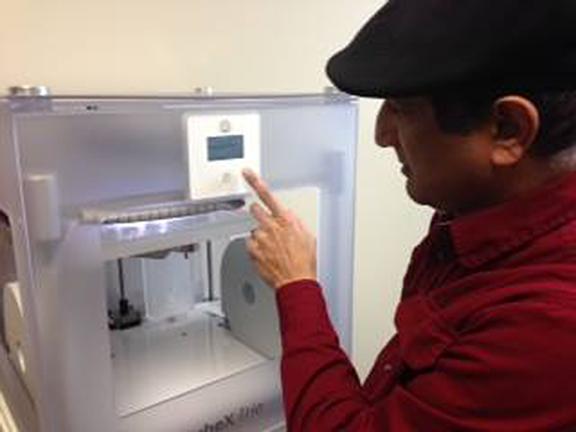New 3-D printer arrives in Washburn art department

Professor Azyz Sharafy demonstrates how to run the new 3-D printer. Washburn hopes to make the printer available for student use in the future.
April 4, 2014
A new $2,500 piece of technology has arrived for Washburn University’s art department. It is called the CubeX Trio, a 3-D printer that can print almost anything, and with over 30 different colors, the possibilities are endless. The CubeX Trio is located in Azyz Sharafy’s office on the first floor of the art building. Unfortunately, faculty members are currently the only people who can use it.
Unlike regular printing, which prints on a flat surface, 3-D printing builds up material to create a real object. It melts filament and draws with it in a very fine layer. It then builds another fine layer of plastic constantly on top of one another until a plastic object is produced.
“In the future, the 3-D printer will be at UMAPS and will be used both by faculty and students at a cost,” said Sharafy.
Faculty at Washburn University will be able to experience what the CubeX Trio 3-D printer can do in a workshop April 4 in Memorial Union’s Kansas room in the upper level of the Union. The presenters are Sharafy, of Washburn’s art department; David Antonacci, the director of teaching and learning KU Medical Center; and James Schmidt, an expert in 3-D printing.
“It is PLA-based plastic material,” said Sharafy.
According to the Cubify website, PLA is a hard plastic that has a low environmental impact . It is derived from a renewable starch-base, mostly using PLA when printing extra-large parts on CubeX as it is a more stable print material.
“It can do any three colors at a go,” said Sharafy.
The CubeX Trio could take two to six hours to make a 3-D model design. Making a cell phone case alone would take two hours. This new piece of technology will be a popular printer for educators in about four years, but for now it is a piece of technology to experiment with and see what there will be for the future.
“The benefits of a 3-D printer for Student Activities & Greek Life would be advertising and designing posters,” said Angela Valdivia, the senior administrative assistant for Student Activities & Greek Life. “Having a 3-D model map of the campus would be more beneficial to incoming and potential students.”
The cost of students having access to the 3-D printer in UMAPS is currently unknown.


